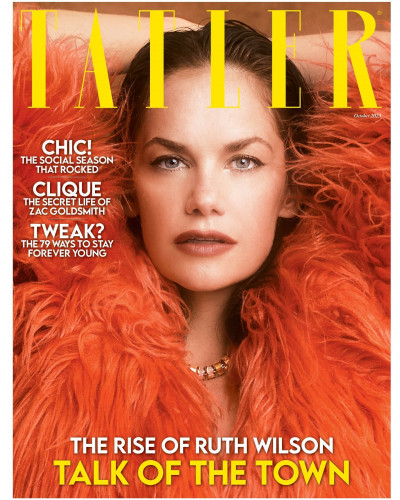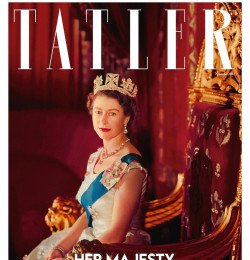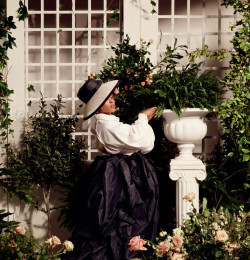Tatler UK


Tatler (also, informally, The Tatler) has been the name of several British journals and magazines, each of which has viewed itself as the successor of the original literary and society journal founded by Richard Steele in 1709. The current incarnation, founded in 1901, is a glossy magazine published by Condé Nast Publications focusing on the glamorous lives and lifestyles of the upper class. A 300th anniversary party for the magazine was held in October 2009.
The original Tatler was founded in 1709 by Richard Steele, who used the nom de plume "Isaac Bickerstaff, Esquire", the first such consistently adopted journalistic personae, which adapted to the first person, as it were, the seventeenth-century genre of "characters", as first established in English by Sir Thomas Overbury and soon to be expanded by Lord Shaftesbury's Characteristics (1711). Steele's idea was to publish the news and gossip heard in London coffeehouses, hence the title, and seemingly, from the opening paragraph, to leave the subject of politics to the newspapers, while presenting Whiggish views and correcting middle-class manners, while instructing "these Gentlemen, for the most part being Persons of strong Zeal, and weak Intellects...what to think." To assure complete coverage of local gossip, a reporter was placed in each of the city's popular coffeehouses, or at least such were the datelines: accounts of manners and mores were datelined from White's; literary notes from Will’s; notes of antiquarian interest were dated from the Grecian Coffee House; and news items from St. James’s.
In its first incarnation, it was published three times a week. The original Tatler was published for only two years, from 12 April 1709 to 2 January 1711. A collected edition was published in 1710–11, with the title The Lucubrations of Isaac Bickerstaff, Esq.
Several later journals revived the name Tatler. Three short series are preserved in the Burney Collection:
* Morphew, the original printer, continued to produce further issues in 1711 under the "Isaac Bickerstaffe" name from 4 January (No. 272) to 17 May (No. 330).
* A single issue (numbered 1) of a rival Tatler was published by Baldwin on 11 January 1711.
* In 1753–4, several issues by "William Bickerstaffe, nephew of the late Isaac Bickerstaffe" were published.
James Watson, who had previously reprinted the London Tatler in Edinburgh, began his own Tatler there on 13 January 1711, with "Donald Macstaff of the North" replacing Isaac Bickerstaffe.
Three months after the original Tatler was first published, Mary Delariviere Manley, using the pen name "Mrs. Crackenthorpe," published what was called the Female Tatler. However, its run was much shorter: the magazine ran for less than a year—from 8 July 1709 to 31 March 1710. The London Tatler and the Northern Tatler were later 18th-century imitations. The Tatler Reviv'd ran for 17 issues from October 1727 to January 1728; another publication of the same name had six issues in March 1750.
On 4 September 1830, Leigh Hunt launched The Tatler: A Daily Journal of Literature and the Stage. He edited it till 13 February 1832, and others continued it till 20 October 1832.
The current publication, named after Steele's periodical, was introduced on 3 July 1901 by Clement Shorter, publisher of The Sphere. For some time a weekly publication, it had a subtitle varying on "an illustrated journal of society and the drama" It contained news and pictures of high society balls, charity events, race meetings, shooting parties, fashion and gossip, with cartoons by "The Tout" and H. M. Bateman.
In 1940, it absorbed The Bystander. In 1961, Illustrated Newspapers, which published Tatler, The Sphere, and The Illustrated London News, was bought by Roy Thomson. In 1965, Tatler was rebranded London Life. In 1968, it was bought by Guy Wayte's Illustrated County Magazine group and the Tatler name restored. Wayte's group had a number of county magazines in the style of Tatler, each of which mixed the same syndicated content with county-specific local content. Wayte, "a moustachioed playboy of a conman" was convicted of fraud in 1980 for inflating the Tatler's circulation figures from 15,000 to 49,000.
It was sold and relaunched as a monthly magazine in 1977, called Tatler & Bystander till 1982. Tina Brown, editor 1979–83, created a vibrant and youthful Tatler and is credited with putting the edge, the irony and the wit back into what was then an almost moribund social title. She referred to it as an upper class comic and by increasing its influence and circulation made it an interesting enough operation for the then owner, Gary Bogard, to sell to the Publishers Condé Nast. She was subsequently airlifted to New York to another Condé Nast title, Vanity Fair.
Several editors later and a looming recession and the magazine was once again ailing and Jane Procter was brought in to re-invent the title for the 1990s. With a sound appreciation of the times - the need for bite not bitch - plus intriguing, newsworthy and gently satirical content, she succeeded in making Tatler a glamorous must-read way beyond its previous social remit. The circulation tripled to over 90,000 - its highest ever figure. Procter was also a gifted marketer and the first to realise the importance of the magazine as a brand. She created the various band on supplements such as The Travel and Restaurant Guides, the famous lists like The Most Invited and The Little Black Book and the hugely popular parties that accompanied them.





